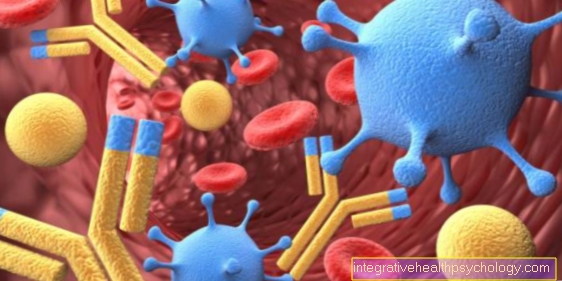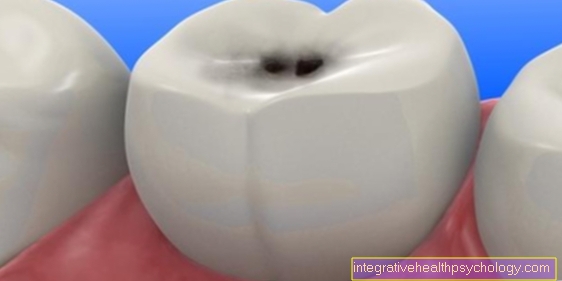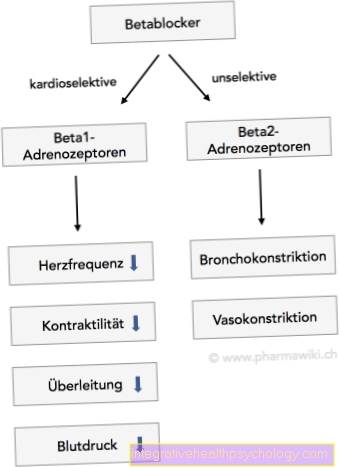Test food allergy
introduction
There are several tests that can be used to determine whether you have a food allergy. However, an interview and physical examination is always carried out first. Skin tests such as the prick test are usually common, but a blood test can also reveal a possible allergy.
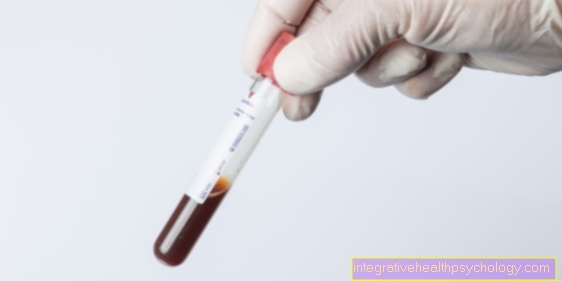
diagnosis
The most important step is to first identify the correct allergen as the trigger.
Diagnosis often begins at home, as parents often quickly suspect certain foods to be triggers. If you experience the symptoms above, omitting the suspected foods can reinforce the suspicion if it leads to the symptoms disappearing.
A reaction can then be provoked by small amounts of the food. If, for example, hives then occur, an allergy to this food is very likely. However, if only gastrointestinal complaints occur, food intolerance cannot be defined and therefore cannot be excluded. Doctors often recommend a similar procedure or keeping a complaint diary that brings food and symptoms into a temporal context, since examining all possible and conceivable allergens is time-consuming and usually superfluous.
If the suspicion has narrowed to a few allergens, a so-called prick test is usually suitable for further diagnosis. Here, the skin on the forearm or on the back is first divided into fields with a pen. A serum containing a specific allergen in concentrated form is applied to each of these fields. This liquid is then placed under the skin using a tiny needle so that the immune system can access it. When the body becomes sensitized to this allergen, i. If you are allergic, a visible and reddened bump will form there after about twenty minutes, as the allergic reaction, as described above, causes water to enter the tissue and cause swelling.
This test is very safe and informative, especially for children. Not only can a statement be made about whether there is a food allergy, but the severity of the allergy can also be assessed via the size of the bump.
In addition, a blood test called the RAST, possible by measuring the amount of antibodies in the blood that are formed against the allergen in question. However, one cannot necessarily infer the severity of the disease from the value measured here. In addition, it happens again and again that the test turns out negative with corresponding symptoms despite the presence of an allergy.
- Allergy diagnostics
- Allergy test
Prick test
The prick test is a skin test that is used to detect various forms of allergy. It is used, for example, to detect contact allergies, hay fever or animal hair allergies. Even if this may seem paradoxical at first, since it is applied to the skin, the prick test is also used in the diagnosis of food allergies.
The basic principle of the prick test is that certain, potentially allergenic substances are applied to the skin of the patient's forearm. They are then inserted into the top layer of skin with a small needle. After a maximum of 60 minutes, the skin is examined for rashes or irritations. If such an irritation is found, it is an indication that the allergen previously applied there actually triggered an allergic reaction in the body.
While there are standardized test substances that are applied to the skin as part of the skin prick test when contact allergies or respiratory allergies are suspected, this is not always the case when food allergies are suspected. This complicates testing for existing food allergies using a prick test to some extent. If there is no industrial test substance for the food to be tested, a so-called prick-to-prick test is used. In this case, some of the allergen to be tested is first picked up with the needle, then the needle is pierced into the top layer of skin.
Before the prick test is carried out, there is an anamnesis. The treating dermatologist tries to narrow down which foods the body is likely to be allergic to by asking specific questions. In order to simplify the anamnesis, it is therefore advisable for the person concerned to keep a food diary in the weeks before so that it becomes clear after which food allergic reactions occurred. Only these foods are then used for the prick test. If there is no indication of which food is the potential allergen, the most important and most common foods should be used as test substances for the prick test.
Also read our topic:
- Food allergy therapy
RAST test
In addition to the exact anamnesis with the help of the food diary and skin tests, blood tests also play an important role in the diagnosis of a food allergy. An essential part of this blood test is the so-called RAST test. RAST stands for Radio-Allergo-Sorbent-Test.
First, blood is drawn from the patient. The blood is then brought into contact with various antigens. These antigens are small amounts of substances that are potentially allergenic. If hay fever is suspected, pollen particles are used as antigens; if animal hair or house dust mites are suspected, they are particles from animal hair or house dust mites. If there is a suspicion of a food allergy, particles from various foods such as nuts, dairy products or chicken protein are used as antigens.
If the body reacts particularly sensitively, i.e. allergically, to one of these antigens, this is shown by the fact that certain antibodies from the patient's blood bind to the appropriate antigen. This is made visible in the laboratory using a color marker. If there is a binding of antibodies from the patient's blood to certain food antigens, this is an indication of an existing allergy to these antigens.
The RAST differentiates how high the concentration of these antibodies is in the patient's blood. In this way, it can be specified more precisely how strongly the body is sensitized to the antigen in question. The antibodies examined using the RAST test are class E antibodies, also known as IgE.
You might also be interested in this topic:
- Allergy emergency kit
How can you test for delayed food allergy?
In recent years and decades there have been repeated discussions about whether there are different types of food allergies.
The classic food allergy belongs to allergy type I, also known as allergy of the immediate type. This type of allergy is mainly mediated by IgE antibodies, which lead to a rapid activation of the immune system. The typical allergic symptoms usually appear within a few minutes.
It is discussed that in addition to this food allergy of the immediate type there are also food allergies of the delayed type. This type of allergy is included in allergy class III and is characterized by the formation of immune complexes, which is primarily mediated by IgG antibodies. So far there are no sufficient studies to be able to make evidence-based statements about the actual existence of delayed food allergies. The problem in the event that such a type of food allergy actually exists would be that the conventional tests, namely the prick test and the RAST test for IgE antibodies, could not sufficiently detect this type of allergy. There are therefore special tests for the detection of IgG antibodies in suspected food allergies of the delayed type. Due to the lack of available studies on the topic, no reliable recommendations for carrying out these tests can be given.
How do you test different types of food allergies?
As already described above, according to the current state of knowledge, there is only one type of food allergy. One speaks here of the immediate type or type I. The existence of food allergies of the delayed type or type III has so far been scientifically controversial and not adequately verified.
Type I food allergies are examined on the basis of a detailed medical history as well as a prick test and blood test (RAST test). In order to detect food allergies of the delayed type (type III), which currently does not exist with certainty, tests have been developed that are specifically designed to detect IgG antibodies in the patient's blood. However, due to the controversial existence of type III food allergies, its usefulness is still uncertain. According to the current recommendations, the prick test and the RAST test continue to serve as the means of choice in the diagnosis of food allergies.
Related topics for more information:
- Allergy to apples
- Cross allergy
What does IgG mean?
IgG is a type of antibody found in the human immune system. A total of 5 different antibody classes are distinguished here. Class A, D, E, G, and M antibodies
IgG is formed as part of the delayed immune response and is retained over a relatively long period of time. IgG antibodies against certain pathogens show, for example, for life that a certain infection, such as Pfeiffer's glandular fever or hepatitis, has been passed through. IgG is also considered a marker for vaccination against certain infections such as measles or hepatitis B.
According to the current state of knowledge, IgG antibodies only play a subordinate role in food allergies. However, there are always studies that deal with the question of the importance of IgG antibodies in food allergies. The existence of an IgG-mediated delayed-type food allergy has been discussed for years.
What does IgE mean?
IgE is also a type of antibody in the human immune system.
IgE antibodies play a key role in the development of allergies. If the body comes into contact with an allergy-causing substance (allergen), IgE antibodies cause certain cells of the immune system to release substances such as histamine. This leads to the typical allergy symptoms such as runny nose, skin rash, itching, cough or even shortness of breath. IgE is an important factor in the RAST test, which checks the presence of IgE antibodies against certain allergens.
Also read:
- Allergic reaction


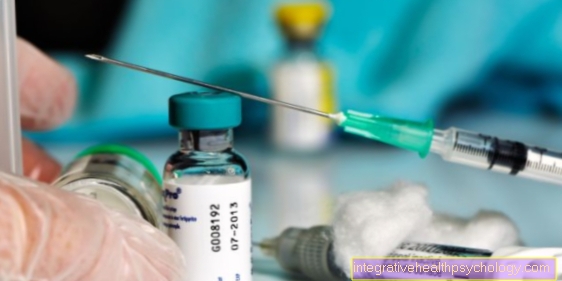







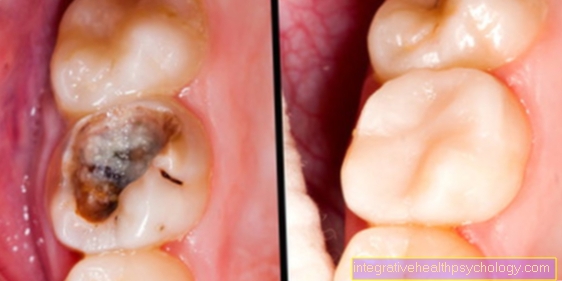



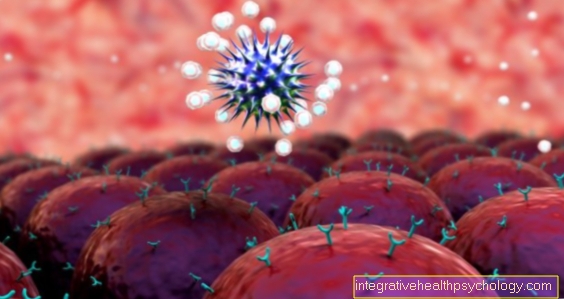
.jpg)






